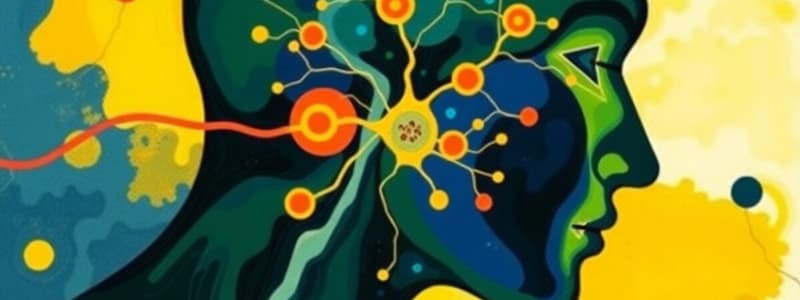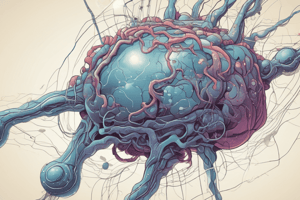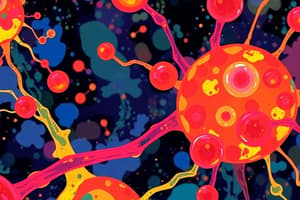Podcast
Questions and Answers
What is the primary function of receptors in neural communication?
What is the primary function of receptors in neural communication?
- To transport neurotransmitters across the synapse
- To bind neurotransmitters and initiate a cellular response (correct)
- To decompose neurotransmitters into inactive forms
- To generate action potentials within the neuron
Which neurotransmitter is often associated with inhibitory functions?
Which neurotransmitter is often associated with inhibitory functions?
- GABA (correct)
- Dopamine
- Serotonin
- Glutamate
What occurs when an action potential reaches the axon terminal?
What occurs when an action potential reaches the axon terminal?
- The neuron undergoes apoptosis
- Ions are absorbed back into the axon
- Dendrites generate new receptors
- Neurotransmitters are released into the synapse (correct)
Which of the following neurotransmitter systems is most directly involved in mood regulation?
Which of the following neurotransmitter systems is most directly involved in mood regulation?
How do neurotransmitters achieve their effects on target cells?
How do neurotransmitters achieve their effects on target cells?
What role does dopamine NOT play in the brain's functions?
What role does dopamine NOT play in the brain's functions?
Which statement best describes norepinephrine?
Which statement best describes norepinephrine?
How do the VTA (DA) neurons respond to unexpected rewards?
How do the VTA (DA) neurons respond to unexpected rewards?
What is the primary effect of propranolol as it relates to PTSD?
What is the primary effect of propranolol as it relates to PTSD?
Which neurotransmitter is most closely linked to the effects of stress and emotion enhancement in memory?
Which neurotransmitter is most closely linked to the effects of stress and emotion enhancement in memory?
What is NOT a function associated with serotonin?
What is NOT a function associated with serotonin?
SSRIs impact serotonin levels primarily by affecting what?
SSRIs impact serotonin levels primarily by affecting what?
What is a characteristic of serotonin receptors?
What is a characteristic of serotonin receptors?
What type of ion channel is associated with ligand-gated receptors?
What type of ion channel is associated with ligand-gated receptors?
Which of the following is the primary excitatory neurotransmitter in the brain?
Which of the following is the primary excitatory neurotransmitter in the brain?
What is the main characteristic of metabotropic receptors compared to ionotropic receptors?
What is the main characteristic of metabotropic receptors compared to ionotropic receptors?
Which of the following is NOT a method of neurotransmitter clean-up?
Which of the following is NOT a method of neurotransmitter clean-up?
Which drug is an antagonist of glutamate?
Which drug is an antagonist of glutamate?
What type of postsynaptic effect do excitatory neurotransmitters like glutamate generally produce?
What type of postsynaptic effect do excitatory neurotransmitters like glutamate generally produce?
How many primary types of glutamate receptors are identified?
How many primary types of glutamate receptors are identified?
What type of effect do ionotropic receptors produce?
What type of effect do ionotropic receptors produce?
What is the primary function of GABA in the brain?
What is the primary function of GABA in the brain?
Which of the following substances are classified as GABA agonists?
Which of the following substances are classified as GABA agonists?
Which of the following neurotransmitters is not a catecholamine?
Which of the following neurotransmitters is not a catecholamine?
Where in the brain is dopamine primarily produced?
Where in the brain is dopamine primarily produced?
Which statement about dopamine receptors is true?
Which statement about dopamine receptors is true?
What was the conclusion of Olds and Milner's research regarding dopamine?
What was the conclusion of Olds and Milner's research regarding dopamine?
How do addictive drugs influence dopamine transmission?
How do addictive drugs influence dopamine transmission?
Which of the following statements regarding metabotropic receptors is accurate?
Which of the following statements regarding metabotropic receptors is accurate?
What is the primary action of SSRIs like Prozac?
What is the primary action of SSRIs like Prozac?
What was found about the efficacy of SSRIs in treating mild to moderate depression?
What was found about the efficacy of SSRIs in treating mild to moderate depression?
Which neurotransmitter is primarily associated with wakefulness and attention?
Which neurotransmitter is primarily associated with wakefulness and attention?
What is the role of endocannabinoids in neurotransmission?
What is the role of endocannabinoids in neurotransmission?
Which substance is known to be a cannabinoid receptor agonist?
Which substance is known to be a cannabinoid receptor agonist?
What are endogenous opioids also known as?
What are endogenous opioids also known as?
What characteristic is notable about adenosine?
What characteristic is notable about adenosine?
What implication is suggested about psychedelics like LSD and psilocybin?
What implication is suggested about psychedelics like LSD and psilocybin?
Study Notes
Introduction to Neural Communication Between Cells
- Neurons communicate via synapses.
- Axon terminals contain vesicles filled with neurotransmitters.
- Action potentials trigger neurotransmitter release into the synapse.
- Dendrites contain receptors that bind to neurotransmitters.
Receptor Types
- Ionotropic receptors are ligand-gated ion channels that open when neurotransmitters bind.
- They produce fast, transient effects.
- They can be excitatory (depolarizing) or inhibitory (hyperpolarizing).
- Metabotropic receptors are G-protein-coupled receptors that modulate cell signalling.
- They have slower, longer-lasting effects.
- They activate signal cascades.
Receptor Locations
- Postsynaptic receptors are located on the postsynaptic cell.
- Presynaptic receptors are located on the presynaptic cell.
- Autoreceptors regulate the release of the same neurotransmitter.
- Heteroreceptors regulate the release of a different neurotransmitter.
Neurotransmitter Clean-up
- Diffusion: Neurotransmitters diffuse away from the synapse.
- Enzymatic degradation: Enzymes break down neurotransmitters.
- Re-uptake: Neurotransmitters are transported back into the presynaptic cell or glial cells (e.g., astrocytes).
Drug Action
- Agonists mimic the effects of neurotransmitters by binding to receptors.
- Antagonists block the effects of neurotransmitters by binding to receptors.
- Other drug actions include:
- Transporter blockers prevent reuptake of neurotransmitters.
- Reuptake inhibitors block the reuptake of neurotransmitters.
- Enzyme inhibitors block the breakdown of neurotransmitters.
Amino Acid Neurotransmitters
- Glutamate: The primary excitatory neurotransmitter.
- Involved in learning, memory, and synaptic plasticity.
- Receptors include AMPAR, NMDAR, Kainate receptors, and mGluR 1–8.
- GABA: The primary inhibitory neurotransmitter.
- Involved in anxiety reduction, sleep, and motor control.
- Receptors include both ionotropic and metabotropic types.
Monoamine Neurotransmitters
- Dopamine (DA):
- Originates in the substantia nigra pars compacta and ventral tegmental area.
- Involved in movement, motivation, reward, and attention.
- Five receptor subtypes (D1R-D5R / D1-D5) are all metabotropic.
- NOT the “pleasure molecule.”
- Norepinephrine (NE):
- Also known as noradrenaline.
- Originates in the locus coeruleus.
- Involved in arousal, attention, and memory.
- Plays a role in stress responses.
- Two main receptor types (⍺1-2, β1-3) with subtypes and sub-subtypes are all metabotropic (GPCRs).
- Serotonin (5-HT):
- Originates in the raphe nuclei.
- Involved in mood, sleep, appetite, and cognition.
- Fifteen receptor subtypes, almost all metabotropic.
- NOT simply the “mood molecule.”
Other Small Neurotransmitters
- Acetylcholine:
- The first discovered neurotransmitter.
- Involved in muscle contraction, learning, and memory.
- Endocannabinoids:
- Two neurotransmitters (anandamide and 2-arachidonoylglycerol).
- Involved in pain perception, appetite, and mood.
- Two receptors (CB1 and CB2) are both GPCRs.
- Adenosine:
- A byproduct of ATP.
- Involved in sleep, wakefulness, and energy metabolism.
- Endogenous Opioids:
- Also known as endorphins.
- Giant peptide neurotransmitters involved in pain perception, reward, and mood.
- Receptors are all GPCRs.
Drugs Affecting Neurotransmitter Systems
- Glutamate antagonists:
- Barbiturates
- Nitrous oxide
- Ketamine
- Ethanol
- GABA agonists:
- Benzodiazepines
- Ethanol
- Chloroform
- Ether
- Dopamine drugs:
- Addictive drugs increase dopamine transmission.
- Norepinephrine antagonists:
- Propranolol (beta blocker) is used in PTSD treatment.
- Serotonin agonists:
- Hallucinogens (LSD, DMT, psilocybin) affect perception and thoughts.
- SSRIs (e.g., Prozac) are used for depression by blocking serotonin reuptake.
- Acetylcholine agonists:
- Nicotine
- Endocannabinoid agonists:
- THC (cannabis)
- Endogenous opioid agonists:
- Heroin
- Fentanyl
- Naloxone (antagonist)
Studying That Suits You
Use AI to generate personalized quizzes and flashcards to suit your learning preferences.
Related Documents
Description
Explore the fascinating world of neural communication between cells. This quiz covers key concepts such as neurotransmitter release, types of receptors, and their functions in synaptic transmission. Test your knowledge on ionotropic and metabotropic receptors as well as their locations.



